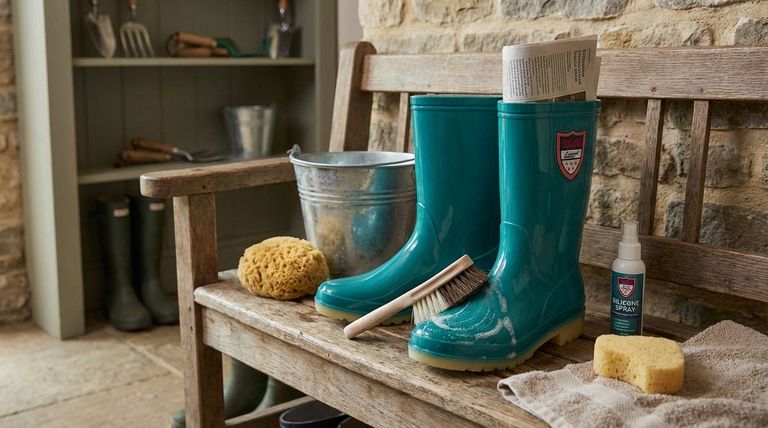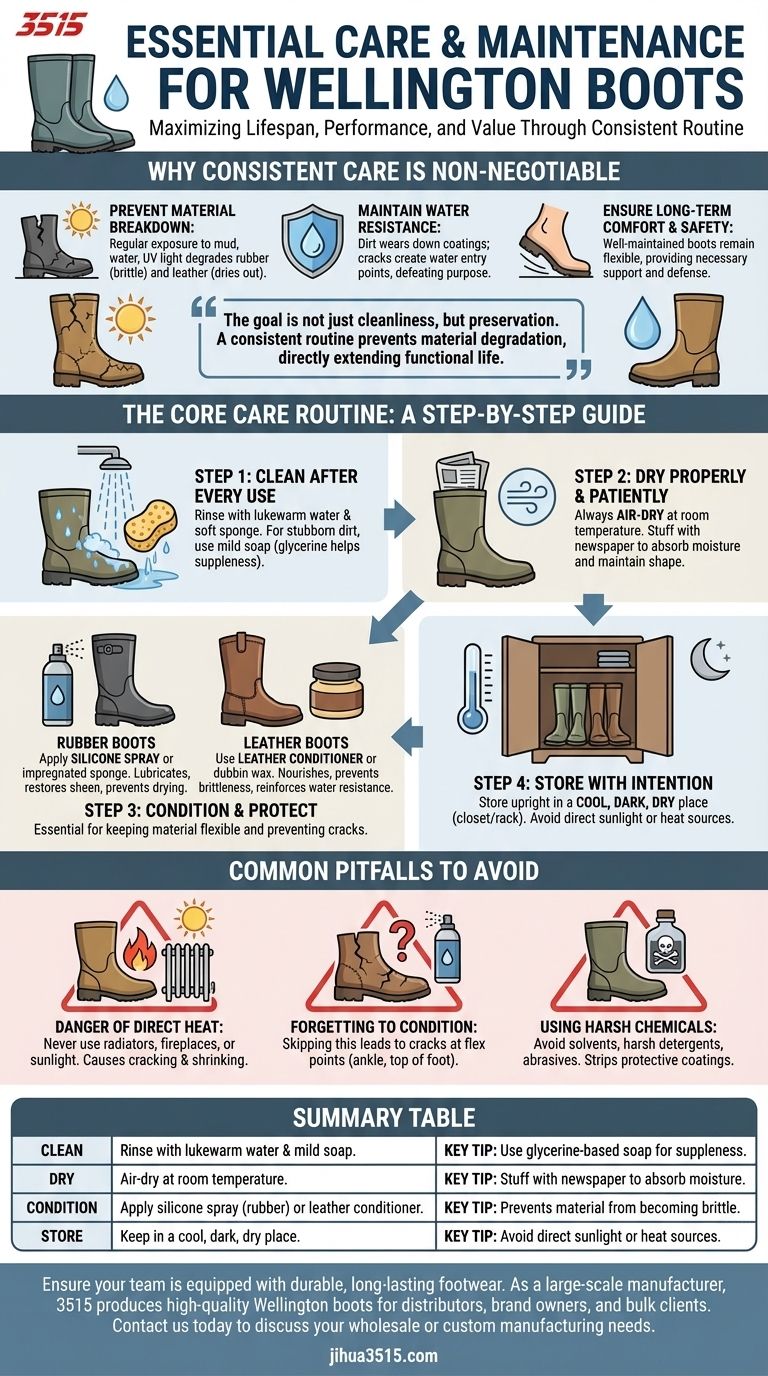To properly care for Wellington boots, you must follow a simple but consistent routine of cleaning, drying, conditioning, and storing them correctly. This involves rinsing them with water after use, allowing them to air-dry away from direct heat, treating the material with a suitable conditioner like silicone spray, and storing them in a cool, dark place to prevent degradation.
The goal of Wellington boot care is not just cleanliness, but preservation. A consistent maintenance routine prevents the material—whether rubber or leather—from cracking and losing its protective qualities, directly extending the functional life of your boots.

Why Consistent Care is Non-Negotiable
Wellington boots are an investment in comfort and protection. Neglecting their care leads to predictable and preventable failures that compromise their core function.
Preventing Material Breakdown
Regular exposure to mud, water, and UV light degrades boot materials. Without proper care, rubber becomes brittle and cracks, while leather dries out, losing its suppleness and water repellency.
Maintaining Water Resistance
The primary job of a Wellington boot is to keep your feet dry. Dirt and grime can wear down protective coatings, and cracks in the material create entry points for water, defeating the boot's purpose.
Ensuring Long-Term Comfort and Safety
Cracked and stiff boots are uncomfortable and offer less protection. A well-maintained boot remains flexible and continues to provide the necessary support and defense against the elements.
The Core Care Routine: A Step-by-Step Guide
Follow these four steps to ensure your boots remain in optimal condition for years. This routine takes only a few minutes but pays significant dividends in longevity.
Step 1: Clean After Every Use
The first step is to remove contaminants that can damage the material over time.
Rinse your boots with lukewarm water and a soft sponge or cloth. For stubborn dirt, use a mild soap solution, preferably one containing glycerine, which helps maintain the material's suppleness.
Step 2: Dry Properly and Patiently
How you dry your boots is one of the most critical factors in their lifespan.
Always air-dry your boots at room temperature. Stuffing them with newspaper is an excellent technique to help absorb internal moisture and maintain their shape.
Step 3: Condition and Protect the Material
Conditioning is essential for keeping the boot material flexible and preventing cracks, but the right product depends on the material.
For rubber boots, apply a silicone spray or use a silicone-impregnated sponge. This lubricates the rubber, restores its sheen, and protects it from drying out.
For leather boots, use a dedicated leather conditioner or dubbin wax. This nourishes the leather, keeps it from becoming brittle, and reinforces its natural water resistance.
Step 4: Store with Intention
Where you keep your boots when not in use directly impacts their longevity.
Store your boots upright in a cool, dry, and dark place, such as a closet or boot rack. Avoid leaving them in direct sunlight or near a heat source, as this will accelerate material aging.
Common Pitfalls to Avoid
Simple mistakes can drastically shorten the life of your boots. Avoiding these common errors is just as important as following the care routine.
The Danger of Direct Heat
Never use a radiator, fireplace, or direct sunlight to speed up the drying process. Intense heat is the fastest way to make rubber brittle and cause leather to crack and shrink permanently.
Forgetting to Condition
Skipping the conditioning step is a common oversight. Without it, rubber boots will inevitably crack at flex points like the ankle and across the top of the foot.
Using Harsh Chemicals
Avoid using solvents, harsh detergents, or abrasive cleaners on your boots. These products can strip protective coatings and break down the chemical structure of the rubber or leather.
Making the Right Choice for Your Boots
Your maintenance approach should align with how you use your boots and their current condition.
- If your primary focus is daily use and longevity: Make the quick rinse and air-dry routine a non-negotiable habit after every single wear.
- If your primary focus is preserving brand-new boots: Begin applying a suitable conditioner (silicone for rubber, wax for leather) within the first month to protect the material from day one.
- If your primary focus is restoring neglected boots: A deep clean and generous conditioning treatment can restore flexibility and improve appearance, but it cannot reverse existing cracks.
Ultimately, treating your Wellington boots with consistent care ensures they will protect you effectively for years to come.
Summary Table:
| Step | Action | Key Tip |
|---|---|---|
| Clean | Rinse with lukewarm water & mild soap. | Use a glycerine-based soap to maintain suppleness. |
| Dry | Air-dry at room temperature. | Stuff with newspaper to absorb internal moisture. |
| Condition | Apply silicone spray (rubber) or leather conditioner. | Prevents material from becoming brittle and cracking. |
| Store | Keep in a cool, dark, dry place. | Avoid direct sunlight or heat sources. |
Ensure your team is equipped with durable, long-lasting footwear. As a large-scale manufacturer, 3515 produces a comprehensive range of high-quality Wellington boots and other footwear for distributors, brand owners, and bulk clients. Our production capabilities ensure you receive reliable products built for performance. Contact us today to discuss your wholesale or custom manufacturing needs.
Visual Guide

Related Products
- Factory Direct Wholesale Rain Boots Durable Waterproof & Fully Customizable
- Factory-Direct Wholesale Canvas Boots with High-Traction Rubber Soles
- Premium KPU Injection Athletic Style Safety Shoes
- Premium Grain Leather Safety Boots for Bulk Supply
- High Performance Fire-Retardant Waterproof Safety Boots
People Also Ask
- What are the liner materials for rain boots? Cotton vs. Blends for Comfort & Durability
- What are the main materials used in the production of rain boots? A Guide to Durability & Comfort
- What are rain boots made of? Discover the best materials for ultimate waterproof protection.
- What are the characteristics of rubber as a rain boot material? Discover Its Durability & Flexibility
- What are the limitations of rain boots in certain climates? Find the Right Footwear for Your Weather



















